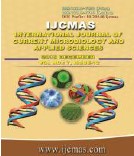


 National Academy of Agricultural Sciences (NAAS)
National Academy of Agricultural Sciences (NAAS)

|
PRINT ISSN : 2319-7692
Online ISSN : 2319-7706 Issues : 12 per year Publisher : Excellent Publishers Email : editorijcmas@gmail.com / submit@ijcmas.com Editor-in-chief: Dr.M.Prakash Index Copernicus ICV 2018: 95.39 NAAS RATING 2020: 5.38 |
As pigeonpea is long duration crop, many flushes of weed germinate at the later stages which compete with the crop. It is therefore, essential to use the post emergence herbicides in conjuction with pre emergence herbicides for the effective control of weeds. Presently, imazethapyr is a very effective post emergence herbicide for controlling broad leaf weeds in kharif pulses including pigeonpea but its weed control efficacy has not been judged in combination with propaquizafop for wide spectrum weed control in different parts of the country including Jabalpur an experiment was conducted at Product Testing Unit, Department of Agronomy, JNKVV, Jabalpur during kharif season of 2015. Weedy check had the highest weed biomass and it was reduced significantly when weeds were controlled either chemically or mechanically. Among the herbicidal treatments, post emergence application of propaquizafop + imazethapyr at 62.5+75 g/ha or higher rate (100+100 g/ha) arrested the weed biomass production remarkably and proved superior to alone application of propaquizafop (50, 62.5, 100 and 125 g/ha), fenaxaprop-p-ethyl (100 g/ha) and imazethapyr (100 g/ha).
 |
 |
 |
 |
 |